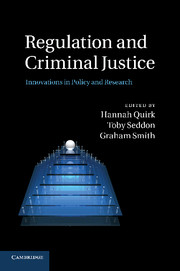Book contents
- Frontmatter
- Contents
- List of figures and tables
- Notes on contributors
- Foreword
- Acknowledgements
- 1 Regulation and criminal justice: exploring the connections and disconnections
- PART I Regulation and criminal justice: framing the debate
- 2 Regulation and its relationship with the criminal justice process
- 3 Reconciling the apparently different goals of criminal justice and regulation: the ‘freedom’ perspective
- 4 On the interface of criminal justice and regulation
- PART II Criminal justice as regulation: responsivity, alternatives and expansion
- PART III Regulation of criminal justice: monitoring, effectiveness and accountability
- Index
- References
4 - On the interface of criminal justice and regulation
Published online by Cambridge University Press: 04 February 2011
- Frontmatter
- Contents
- List of figures and tables
- Notes on contributors
- Foreword
- Acknowledgements
- 1 Regulation and criminal justice: exploring the connections and disconnections
- PART I Regulation and criminal justice: framing the debate
- 2 Regulation and its relationship with the criminal justice process
- 3 Reconciling the apparently different goals of criminal justice and regulation: the ‘freedom’ perspective
- 4 On the interface of criminal justice and regulation
- PART II Criminal justice as regulation: responsivity, alternatives and expansion
- PART III Regulation of criminal justice: monitoring, effectiveness and accountability
- Index
- References
Summary
At first glance, one might be tempted to regard systems of regulation and of criminal justice as essentially unrelated. But like humans compared to other primates, regulation and criminal justice have much in common. The theorists and practitioners of each have learned a great deal, and have a great deal yet to learn, from each other. This chapter will explore the interface of regulation and criminal justice. It will identify how principles and strategies of each have been used, with varying success, by devotees of the other. First, it will discuss criminal justice as an instrument of regulation. Criminal justice is, in fact, one component of a regulatory system; the most egregious examples of regulatory non-compliance may incur criminal liability. Then, the chapter will discuss regulation as an instrument of criminal justice. There are many regulatory activities that are incidental to criminal justice. When functioning properly, these may preclude the necessity for mobilizing the criminal process. A great deal of crime prevention, for example, is based on regulation. The chapter will then explore some common theoretical bases. Both regulation more generally, and criminal justice as a subset, can entail similar techniques, such as contracting out, or the use of coercive powers. Their relative efficiency and effectiveness within and between regulatory and criminal justice domains is an important question. Finally, the chapter will discuss normative principles that might govern the various measures that might be brought to bear in regulatory and criminal justice domains.
- Type
- Chapter
- Information
- Regulation and Criminal JusticeInnovations in Policy and Research, pp. 72 - 100Publisher: Cambridge University PressPrint publication year: 2010
References
- 6
- Cited by



